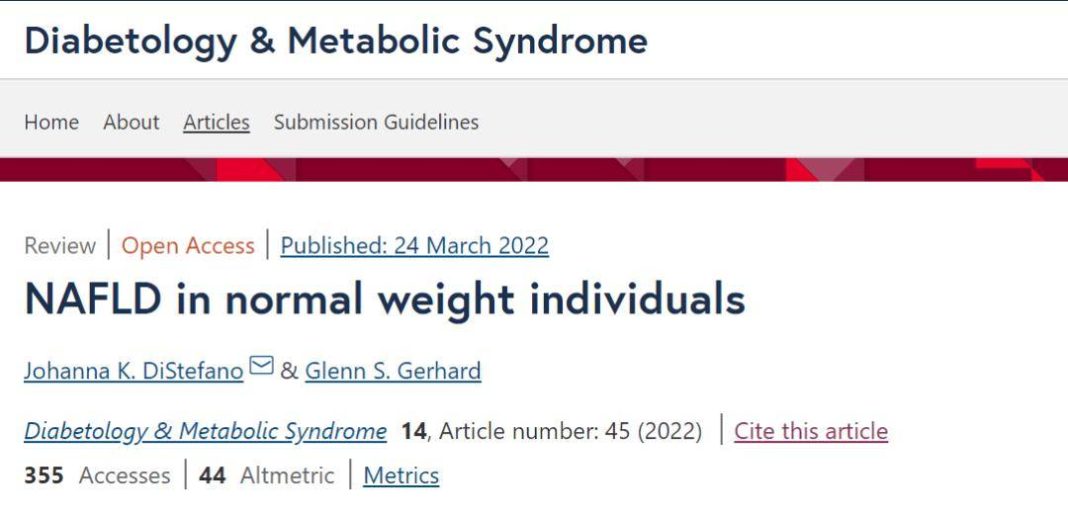In the impression of many people, fatty liver is only a “patent” for the obese. However, many fatty liver patients are not only not overweight but also slender.
Currently, 1/4 to 1/3 of adults worldwide suffer from non-alcoholic fatty liver disease (NAFLD), with about 10% of “lean” patients.
Why do lean people also get fatty liver?
A review published in “Diabetology & Metabolic Syndrome” summarized the probability, clinical characteristics, and health outcomes of lean individuals with NAFLD and analyzed five major potential factors that could lead lean individuals to develop NAFLD, with diet being an important assessment factor.
Source: Diabetology & Metabolic Syndrome
There may be many factors contributing to the development of NAFLD without excessive obesity (as shown in the figure), such as environmental factors, genetic susceptibility, endocrine and metabolic factors, etc., and most of these factors may interact with each other.
The study pointed out that excessive intake of fructose, refined carbohydrates, sugary drinks, saturated fats, and animal proteins are the main factors in the development of NAFLD. Regular consumption of fructose can induce liver fat production and endoplasmic reticulum stress, impair fatty acid oxidation, deplete beneficial bacteria in the intestine, cause liver inflammation by producing uric acid and intestinal endotoxins. In addition, fructose may also indirectly lead to insulin resistance in the liver.
In addition, compared to obese fatty liver, genetic factors are more important in lean fatty liver, and they are related to the severity of fatty liver.
Protein malnutrition is another cause of lean individuals developing fatty liver. Lean fatty liver patients may have certain chronic digestive diseases that result in a low supply of protein.
When protein synthesis decreases, the breakdown and utilization of body fat accelerate, causing a large amount of fatty acids to be released from adipose tissue into the liver, resulting in the accumulation of a large amount of fat in the liver, which may cause damage to the liver.
In summary, compared to NAFLD patients with higher BMI, lean fatty liver patients may have an increased risk of cardiovascular diseases, malignancies, progressive liver diseases, and related mortality.
How can lean fatty liver patients “save” themselves?
For lean fatty liver, treatment methods are usually similar to obese NAFLD patients, with lifestyle changes and weight reduction being crucial.
Aim to reduce weight by 3% to 5%
Although these patients are already lean, if they do not lose weight, the problem of fat accumulation in the liver is difficult to resolve. It is best to lose weight within the normal range of body mass index (18.5 to 23.9). For example, 2.5 kilograms for 50 kilograms, 5 kilograms for 100 kilograms.
Studies have shown that a 5% weight loss can significantly improve aspartate aminotransferase and alanine aminotransferase levels, as well as liver fat degeneration and liver hardness.
In addition, men should have a waist circumference of <85cm, and women should have a waist circumference of <80cm, as central obesity increases the risk of fatty liver disease.
It is important to note that weight loss should not be too rapid, ideally controlling it within 0.5 to 1 kilogram per week. If excessive fat decomposition occurs in the body in a short period, surpassing the liver’s metabolic capacity, fatty liver may worsen.
Try the Mediterranean diet pattern
Limit daily eating to 8 to 12 hours, avoid drinking sugary beverages, reduce fat intake, eat more fiber-rich vegetables and whole grains, ensure intake of high-quality proteins, and limit eating before bedtime.
Scientific drug treatment
If lifestyle interventions are ineffective, drug treatment is needed, and specific medications should be taken under the guidance of a physician.
Regular follow-up screening
It is recommended that lean individuals with fatty liver or signs of cirrhosis undergo abdominal ultrasound examination twice a year, and additional tests for alpha-fetoprotein levels may be performed to monitor the occurrence of liver cancer.
A study published in the “World Journal of Gastroenterology” suggested that if a slender person has high indicators of waist-to-height ratio, hemoglobin, or triglycerides, consider checking for fatty liver.
▼
Past highlights
▼
Tea or Coffee: Which is healthier? Don’t be indecisive! This way is better…
Grapes are sweet but friendly to blood pressure and lipids, can also reduce the risk of fatty liver
Unconscious weight loss habits, how many do you have?


